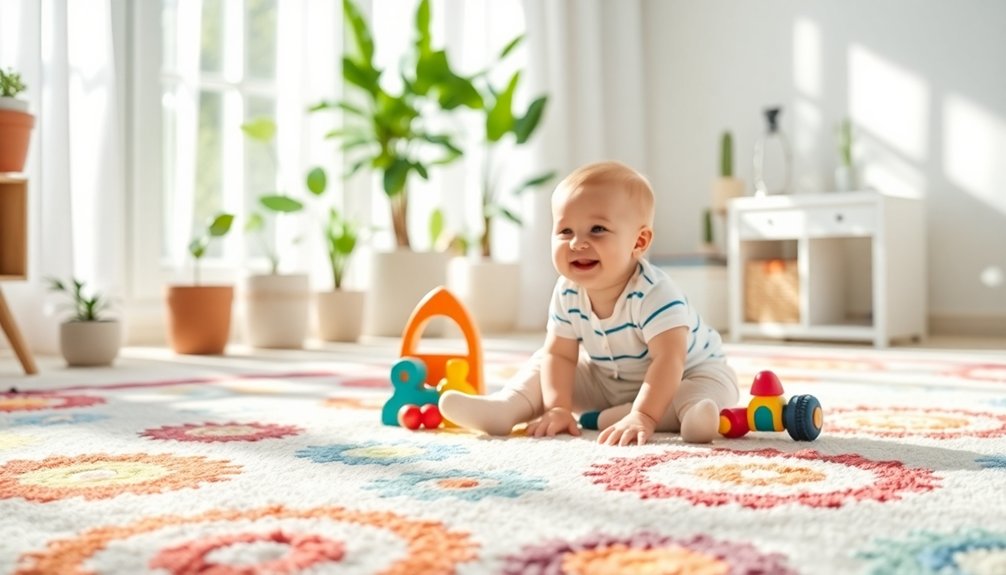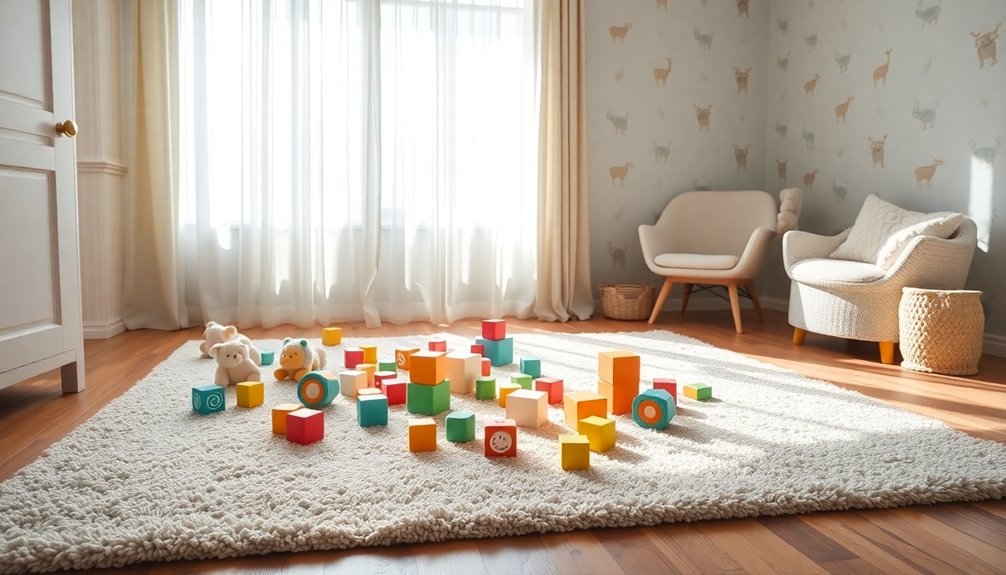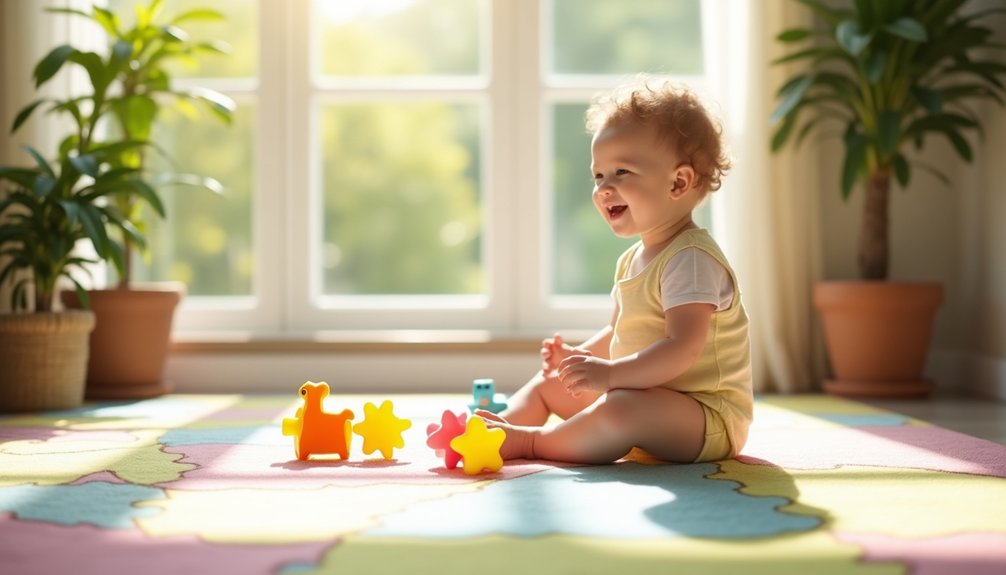Polypropylene rugs can be safe for babies, but you need to consider potential risks. While they're generally non-toxic and meet FDA and EPA standards, low-quality options may emit volatile organic compounds (VOCs) that can irritate your baby's respiratory system. Regular cleaning can help minimize dust and harmful particles. To ensure a truly safe play area, consider alternatives like natural fiber rugs, which are hypoallergenic and free from harmful chemicals. Prioritizing safe materials reduces allergy risks for your little one. There's much more to explore about creating a non-toxic environment for your baby.
Key Takeaways
- Polypropylene rugs are generally considered non-toxic, but may contain harmful additives that could pose risks to infants.
- VOC emissions from polypropylene rugs can irritate respiratory systems and contribute to allergies in babies.
- Regular cleaning and maintenance can minimize dust and potential harmful compounds in polypropylene rugs.
- Natural fiber rugs, such as cotton or wool, are safer alternatives for creating non-toxic play areas for infants.
- Ensure rugs have non-slip backing and are easy to clean to maintain a safe environment for babies.
Chemical Composition and Safety
When choosing polypropylene rugs for your baby's space, understanding their chemical composition and safety is crucial. Polypropylene is a synthetic material made from propylene, formed by melting gas-derived plastic pellets. Its isotactic structure enhances thermal resistance, making it a durable option.
While polypropylene is resistant to fats and most solvents, it's also known for being non-toxic plastics, making it a safer option for households with children. Some rugs may contain red dyes linked to cancer in rats or styrene, which has been associated with certain cancers. Low-quality polypropylene can emit volatile organic compounds (VOCs), impacting indoor air quality. However, polypropylene rugs are FDA-approved and deemed safe for consumer use, with the EPA considering them a safer choice compared to other plastics. They're also less flammable and resistant to moisture and mildew, beneficial for allergy-prone households.
To ensure safety, look for rugs with certifications indicating environmental compliance and low VOC emissions. Regular maintenance and cleaning can further reduce any potential risks. Polypropylene rugs are also recyclable and classified as plastic #5, which indicates lower toxicity compared to many other plastics.
With a variety of colors and designs available, you can find a polypropylene rug that complements your baby's space while prioritizing safety.
Health Risks for Infants
Polypropylene rugs, while popular for their aesthetics and durability, can pose significant health risks for infants. These rugs can emit volatile organic compounds (VOCs) that may irritate your baby's respiratory system, potentially leading to asthma-like symptoms and breathing difficulties. You might notice your little one developing allergies as a result of prolonged exposure to these harmful fumes. Additionally, VOCs can contribute to developmental delays and hormone imbalances, impacting your infant's growth and overall development. Furthermore, polypropylene rugs contribute to land and water pollution that affects human health and wildlife. Dizziness and headaches may also occur due to inhaling fine particles from the rugs.
Skin and eye irritations are another concern. If your baby comes into contact with the powder or fines from the rug, they could experience mild to severe skin irritation, and the particles can even irritate their eyes. Prolonged exposure may lead to chronic health problems, too, which is something no parent wants for their child. Furthermore, it is important to note that regular cleaning can help minimize dust accumulation and reduce exposure to any harmful compounds. Lastly, while the ingestion of polypropylene particles is unlikely, it could still cause gastrointestinal irritation. It's crucial to consider these health risks when creating a safe play area for your baby.
Environmental Concerns

The environmental impact of polypropylene rugs raises serious concerns for both our planet and future generations. Since these rugs are made from petroleum, their production contributes significantly to climate change through greenhouse gas emissions. The extraction and refining processes also release pollutants into the environment, exacerbating ocean pollution and degrading vital ecosystems. Moreover, polypropylene rugs aren't biodegradable. When they end up in landfills, they can leach harmful chemicals into the soil and groundwater, posing risks to plant life and local water sources. The decomposition of these rugs also releases methane, a potent greenhouse gas, further polluting our air. Additionally, polypropylene rugs emit volatile organic compounds (VOCs) like benzene and toluene, which can deteriorate indoor air quality and cause health issues, especially for your little ones. This off-gassing can create a chemical odor that lingers in your home, adding another layer of concern. You might want to consider eco-friendly alternatives, such as rugs made from natural materials like wool or jute. These options are biodegradable and non-toxic, helping to reduce your environmental footprint while ensuring a safe play area for your child.
Maintenance and Cleaning Tips
To keep your polypropylene rug looking fresh and vibrant, regular maintenance is key. Here are some essential tips to ensure your rug stays in top shape:
| Task | Tips | |
|---|---|---|
| Vacuum Frequently | Use adjustable suction and vacuum in all directions. Focus on high-traffic areas. | |
| Spot Clean | Blot spills immediately and scrub with a soap solution. Rinse with clean water to remove soap residue. | |
| Stubborn Stains | Use a bleach solution (90% water, 10% bleach) and blot in circular motions. Rinse thoroughly after cleaning. | |
| All Over Clean | Hose down the rug, apply soap, scrub with a brush, and rinse thoroughly. Dry in the sun to avoid moisture issues. | Regular maintenance also involves protecting your rug from UV damage, which can cause fading and discoloration, to prolong its lifespan. |
If the rug needs a deep clean, consider professional cleaning services. They can effectively restore your rug's original appearance without the hassle. Regular maintenance not only enhances aesthetics but also prolongs the life of your rug, ensuring it remains a safe and inviting space for your little ones. Additionally, consistent cleaning helps maintain overall rug appearance, making it a crucial aspect of your rug care routine.
Safe Rug Alternatives

When creating a safe play environment for your baby, choosing the right rug is essential. You want to prioritize materials that minimize the risk of allergies and chemical exposure. Ensuring rugs are made from natural fibers helps to contribute to baby safety. Consider looking for rugs made from materials like polypropylene (PP) which is food-grade plastic and generally non-toxic.
Here are three safe rug alternatives to consider:
- Natural Fibers: Look for rugs made from cotton, wool, or bamboo. These materials are non-toxic, hypoallergenic, and soft, providing a comfortable play area for your little one.
- Non-Synthetic Materials: Choose rugs dyed with natural dyes and free from chemical treatments, like flame retardants. Make sure they've non-slip backing to prevent accidents, and opt for machine-washable options for easy cleaning.
- Alternative Play Surfaces: Consider options like engineered wood fiber or rubber mulch for outdoor play areas. These materials are designed for safety, offering good shock absorption and durability.
Frequently Asked Questions
How Can I Identify a Non-Toxic Polypropylene Rug?
To identify a non-toxic polypropylene rug, check for certifications like GOTS and OEKO-TEX, ensure it's made from 100% polypropylene, verify low VOC emissions, and assess the manufacturing process for sustainability and minimal harmful chemicals.
What Certifications Should I Look for in Rug Safety?
When choosing a rug, look for GOTS, OEKO-TEX, GreenGuard Gold, and ISO certifications. These ensure the rug's safety, low emissions, and non-toxic materials, helping you create a healthy environment for your home.
Are There Specific Brands Known for Safe Rugs?
When searching for safe rugs, consider brands like Lorena Canals, Nestig, and Totter + Tumble. They use organic materials and nontoxic dyes, ensuring you create a safe and comfortable space for your little one.
Can Polypropylene Rugs Cause Skin Irritation in Babies?
Polypropylene rugs can cause skin irritation, especially if your baby has sensitive skin. Off-gassing and contact with rug particles may trigger reactions, so keep an eye on any signs of irritation and ensure proper ventilation.
How Long Do Polypropylene Rugs Typically Last?
Polypropylene rugs typically last many years with proper care. Their exceptional durability and stain resistance make them ideal for high-traffic areas. You'll appreciate their low maintenance, keeping your space looking fresh and vibrant effortlessly.

